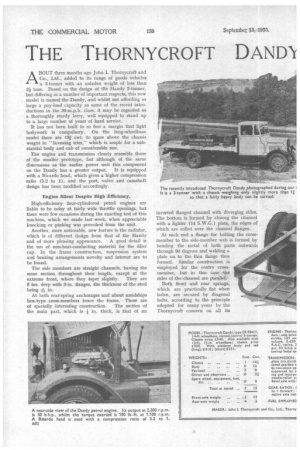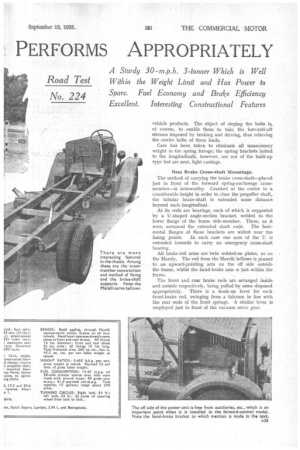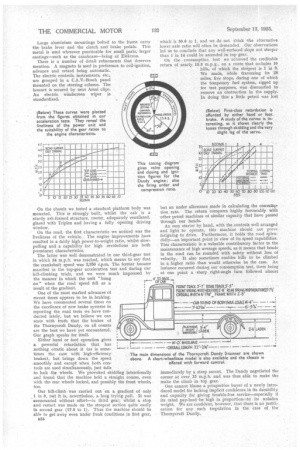THE THORNYCROFT DANIn
Page 42

Page 43

Page 44

If you've noticed an error in this article please click here to report it so we can fix it.
PERFORMS APPROPRIATELY•
ABOUT three months ago John I. Thornycroft and Co., Ltd., added to its range of goods vehicles a 3-tonner with an unladen weight of less than 2-itons. Based on the design of the Handy 2-tormer, but differing in a number of important respects, this new model is named the Dandy, and whilst not affording so large a pay-load capacity as some of the recent introductions in the 30-.m.p.h. class, it may be regarded as a thoroughly sturdy lorry, well equipped to stand up to a large number of years of hard service.
It has not been built to so fine a margin that light bodywork is compulsory. On the long-wheelbase model there are in cwt. to spare above the chassis weigtit in "licensing trim," which is ample for a substantial body and cab of considerable size.
The engine and transmission closely resemble those of . the smaller prototype, but although of the same dimensions as the earlier power unit this component on the Dandy has a greater output. It is equipped with a Ricardo head, which gives a higher compression ratio (5.2 to 1), and the port, valve and camshaft design has been modified accordingly.
Engine Silent Despite High Efficiency.
High-efficiency four-cylindered petrol engines are liable to be noisy at fairly wide throttle openings, but there were few occasions during the exacting test of this machine, which we made last week, when appreciable knocking or pinking was provoked from the unit.
Another, more noticeable, new feature is the radiator, which is of different design from that of the Handy and of more pleasing appearance. A good detail is the use of non-heat-conducting material for the filler cap. In the frame construction, suspension system and braking arrangements -novelty and interest are to be found.
The side members are straight channels, having the same section throughout their length, except at the extreme front, where they taper slightly. They are 5 ins, deep with 3-in. -flanges, the thickness of the steel being -Ain.
At both rear-spring anchorages and about amidships box-type cross-members brace the frame. These are of specially interesting construction. The section of the main part, which is i in, thick, is that of an inverted flanged channel with diverging sides. The bottom is formed by closing the channel with a lighter (14 S.W.G.) plate, the edges of which are rolled over the channel flanges.
At each end a flange for bolting the crossmember to the side-member web is formed by bending the metal of both parts outwards through 90 degrees and welding a plate on to the thin flange thus formed. Similar construction is employed for the centre crossmember, but in this case Jilt) sides of the channel are parallel.
Both front and rear springs, which are practically flat when laden, are secured by diagonal bolts, according to the principle adopted for many years by the Thornycroft concern on all its vehicle products. The nbject of sloping the bolts is, at course, to enable them to tsiie the lore-and-aft stresses imposed by braking and driving, thus relieving the centre bolts of these loads.
Care has been taken to eliminate all unnecessary weight in the spring fixings; the spring brackets bolted to the longitudinals, however, are not of the built-up type but are neat, light castings.
Neat Brake Cross-shaft Mountings.
The method of carrying the brake cross-shaft—placed just in front of the forward spring-anchorage crossmember—is noteworthy. Cranked at the centre to a considerable height in order to clear the propeller shaft, the tubular brake-shaft is extended some distance beyond each longitudinal.
At its ends are bearings, each of which is supported by a II-shaped angle-section bracket, welded to the lower flange of the frame side-member. These, as it were, surround the extended shaft ends. The horizontal flanges of these brackets are widest near the _thong points. In each case one arm of the Ti is extended inwards to carry an emergency cross-shaft bearing.
All brake-rod arms are twin welded-on plates, as on the Handy. The rod from the Morelli bellows is pinned to an upward-pointing arm on the off side outside the frame, whilst the hand-brake arm is just within the frame.
The front and rear brake rods are Arranged inside and outside respectively, being pulled by aims disposed appropriately. There is a hook-up lever for each front-brake rod, swinging from a fulcrum in line with the rear ends of the front springs. A similar lever is employed just in front of the vacuum servo gear.
Large aluminium mountings bolted to the frame carry the brake lever and the clutch and brake pedals. This metal is used wherever practicable for small parts, larger castings—such as the crankcase—being of Elektron.
There is a number of detail refinements that deserves mention. A magneto is used in preference to coil-ignition, advance and retard being automatic.
The electric controls, instruments, etc., are grouped in a C.A.V.-Bosch panel mounted on the steering column. The bonnet is secured by neat Amal clips. An electric windscreen wiper is standardized.
On the chassis we tested a standard platform body was mounted. This is strongly built, whilst the cab is a sturdy ash-framed structure, roomy, adequately ventilated, glazed with Triplex and having a fully opening driving window.
On the road, the first characteristic we noticed was the liveliness of the vehicle. The engine improvements have resulted in a fairly high power-to-weight ratio, whilst slowpulling and a capability for high revolutions are both prominent characteristics.
The latter was well demonstrated in our third-gear test in which 34 m.p.h. was reached, which means to say that the crankshaft speed was 3,350 r.p.m. The former became manifest in the top-gear acceleration test and during our hill-climbing trials, and we were much impressed by the manner in which the unit "hung on" when the road speed fell as a result of the gradient.
One of the most marked advances of recent times appears to be in braking. We have commented several times on the excellence of new brake systems in reporting the road tests we have conducted lately, but we believe we can state with truth that the brakes of the Thornycroft Dandy, on all counts are the best we have yet encountered. Our graph speaks for itself.
Either hand or foot operation gives a powerful retardation that has nothing erratic about it (as is sometimes the case with high-efficiency brakes), but brings down the speed smoothly and except when both controls are used simultaneously, just fails to lock the wheels. We provoked skidding intentionally and found that the machine held a straight course, even with the rear wheel ,3 locked, and possibly the front wheels, too.
Our hill-climb was carried out 'on a gradient of only 1 in 9, but it is, nevertheless, a long trying pull. It was
surmounted without effort—in third gear, whilst a stop and restart was made on the steepest section quite easily in second gear (17.5 to 1). Thus the machine should be able to get away even under freak conditions in first gear,
r
which is 30.6 to 1, and we do not think 'the alternative lower axle ratio will often be demanded. Our observations led us to conclude that any well-surfaced slope not steeper than 1 in 14 could be ascended in top gear.
On the consumption test we achieved the creditable return of nearly, 15.5 m.p.g., on a roate that includes 10 hills, of which the steepest is 1 in 9. We made, while traversing its 28 miles, five stops, during one of which the temporary fuel system, rigged up for test purposes, was dismantled to remove an obstruction in the supply. In doing this a little petrol was lost but an under allowance made in calculating the consumption rate. The return compares highly favourably with other petrol machines of similar capacity that have passed through our hands.
An easy starter by hand, with the controls well arranged and light to operate, this machine should not prove fatiguing to drive. Furthermore, it holds the road splendidly—an important point in view of its speed capabilities. This characteristic is a valuable contributory factor to the maintenance of high average speeds, as it means that bends in the road can be rounded with safety without loss of velocity. It also sometimes enables hills to be climbed in a higher ratio than would otherwise be the case. All instance occurred during our consumption test, there being
_ at one point a sharp right-angle turn followed almost immediately by a steep ascent. The Dandy negotiated the corner at over 15 m.p.h. and was thus able to make the make the climb in top gear.
One cannot blame a prospective buyer of a newly introduced model for lacking implicit confidence in its durability and capacity for giving trouble-free service—especially if its rated pay-load be high in proportion, ,to its unladen weight. We are confident, however, that there is no justification for any such trepidation in the case of the Thornycroft Dandy.




















































































